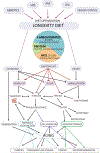Nutrition, longevity and disease: From molecular mechanisms to interventions
- PMID: 35487190
- PMCID: PMC9089818
- DOI: 10.1016/j.cell.2022.04.002
Nutrition, longevity and disease: From molecular mechanisms to interventions
Abstract
Diet as a whole, encompassing food composition, calorie intake, and the length and frequency of fasting periods, affects the time span in which health and functional capacity are maintained. Here, we analyze aging and nutrition studies in simple organisms, rodents, monkeys, and humans to link longevity to conserved growth and metabolic pathways and outline their role in aging and age-related disease. We focus on feasible nutritional strategies shown to delay aging and/or prevent diseases through epidemiological, model organism, clinical, and centenarian studies and underline the need to avoid malnourishment and frailty. These findings are integrated to define a longevity diet based on a multi-pillar approach adjusted for age and health status to optimize lifespan and healthspan in humans.
Copyright © 2022 The Authors. Published by Elsevier Inc. All rights reserved.
Conflict of interest statement
Declaration of interests V.D.L. has equity interest in L-nutra, and is a member of its scientific advisory board. V.D.L. has patents related to fasting mimicking diets, discussed in this review.
Figures


References
-
- Bartke A (2005). Insulin resistance and cognitive aging in long-lived and short-lived mice. J Gerontol A Biol Sci Med Sci 60, 133–134. - PubMed
Publication types
MeSH terms
Grants and funding
LinkOut - more resources
Full Text Sources
Other Literature Sources

